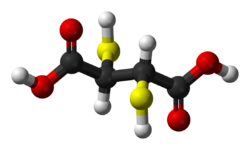Chemistry:Dimercaptosuccinic acid
 | |
 | |
| Clinical data | |
|---|---|
| Pronunciation | Succimer /ˈsʌksɪmər/ |
| Trade names | Chemet, others |
| Other names | (2R,3S)-2,3-Dimercaptosuccinic acid meso-2,3-Dimercaptosuccinic acid Succimer APRD01236 |
| AHFS/Drugs.com | Monograph |
| Pregnancy category |
|
| ATC code | |
| Identifiers | |
| |
| CAS Number | |
| PubChem CID | |
| ChemSpider | |
| UNII | |
| ChEMBL | |
| Chemical and physical data | |
| Formula | C4H6O4S2 |
| Molar mass | 182.21 g·mol−1 |
| 3D model (JSmol) | |
| Melting point | 125 °C (257 °F) |
| |
| |
Dimercaptosuccinic acid (DMSA), also called succimer, is a medication used to treat lead, mercury, and arsenic poisoning.[1] When radiolabeled with technetium-99m, it is used in a number of types of diagnostic testing.[2] A full course is 19 days of medications by mouth.[1] More than two weeks should pass before a second course is given.[1]
Common side effects include vomiting, diarrhea, rash, and low blood neutrophil levels.[1] Liver problems and allergic reactions may also occur with use.[1] Whether use during pregnancy is safe for the baby is unclear.[3] Dimercaptosuccinic acid is in the chelating agent family of medications.[1] It works by binding with lead and a number of other heavy metals, allowing them to leave the body in the urine.[1]
Dimercaptosuccinic acid has been used medically since the 1950s.[4][5] It is on the World Health Organization's List of Essential Medicines.[6] In the United States, no generic version was available as of 2015.[7]
Medical uses
Dimercaptosuccinic acid is indicated for the treatment of lead poisoning in children with blood level measured above 45 µg/dl. The use of DMSA is not approved for prevention of lead poisoning in anticipation of exposure in known lead-contaminated environments. DMSA can cross the blood–brain barrier of mice,[8] but it is not known if this is also the case in humans.[9] Even if DMSA cannot reverse the damages done to the central nervous system, it might prevent further deterioration.[10]
DMSA facilitates urinary excretion of lead, and with sufficiently aggressive treatment, can reduce lead content in the brain.[11] It also increases urinary excretion of copper and zinc.[12] DMSA improved cognitive function in rats that had been exposed to lead, but reduced cognitive function in rats that had not been exposed to lead.[11]
Chemistry
It is the organosulfur compound with the formula HO2CCH(SH)CH(SH)CO2H. This colorless solid contains two carboxylic acid and two thiol groups, the latter being responsible for its mildly unpleasant odour. It occurs in two diastereomers, meso and the chiral dl forms.
The 2,3-dimercaptosuccinic acid molecule has two stereocentres (two asymmetric carbon atoms), and can exist as three different stereoisomers. The 2S,3S and 2R,3R isomers are a pair of enantiomers, whereas the 2R,3S isomer is a meso compound and thus optically inactive.
 |
150px | 
|
 |
150px | 
|
| (2R,3R)-2,3-dimercaptosuccinic acid | (2R,3S)-2,3-dimercaptosuccinic acid (meso-2,3-dimercaptosuccinic acid) |
(2S,3S)-2,3-dimercaptosuccinic acid |
Preparation and reactivity
DMSA may be prepared by reacting acetylenedicarboxylic acid with sodium thiosulfate[13] or thioacetic acid followed by hydrolysis. The dimethyl ester is also known.[14]
Meso 2,3-dimercaptosuccinic acid binds to "soft" heavy metals such as Hg2+ and Pb2+, mobilizing these ions for excretion. It binds to metal cations through the thiol groups, which ionize upon complexation.
History
DMSA was first synthesized by V. Nirenburg in the Urals Polytechnic Institute, commissioned by one of the electrical enterprises of Sverdlovsk, which consumed many tons of mercury and was looking for a medicine to prevent poisoning of personnel. In 1957, Chinese scientists found that DMSA can effectively treat antimony poisoning due to overdose of tartar emetic.[15] Pronounced protective effect in animal poisoning with arsenic and mercury was first shown by I. Okonishnikova in 1962. In 1984, the now-defunct Bock Pharmaceutical Company requested the FDA grant approval for orphan drug status under the trade name Chemet and the FDA approved of this in 1991, providing exclusivity until 1998 which was conveyed to the successor Sanofi in 1996.[16][17]
See also
- 2,3-Dimercapto-1-propanesulfonic acid
- Chelation therapy
- DMSA scan
- EDTA
- Mercury poisoning
- Succinic acid
- Tartaric acid
References
- ↑ 1.0 1.1 1.2 1.3 1.4 1.5 1.6 "Succimer". The American Society of Health-System Pharmacists. https://www.drugs.com/monograph/succimer.html.
- ↑ Biersack, H.-J.; Grünwald, F. (2005) (in en). Thyroid Cancer. Springer Science & Business Media. p. 213. ISBN 9783540278450. https://books.google.com/books?id=lncDay233rYC&pg=PA213.
- ↑ "Succimer (Chemet) Use During Pregnancy". https://www.drugs.com/pregnancy/succimer.html.
- ↑ Miller, Alan (June 1998). "Dimercaptosuccinic acid (DMSA), a non-toxic, water-soluble treatment for heavy metal toxicity.". Alternative Medicine Review 3 (3): 199–207. PMID 9630737.
- ↑ Chappell, W. R.; Abernathy, C. O.; Calderon, R. L. (1999) (in en). Arsenic Exposure and Health Effects III. Elsevier. p. 350. ISBN 9780080527574. https://books.google.com/books?id=YMsi_gdILu4C&pg=PA350.
- ↑ World Health Organization model list of essential medicines: 21st list 2019. Geneva: World Health Organization. 2019. WHO/MVP/EMP/IAU/2019.06. License: CC BY-NC-SA 3.0 IGO.
- ↑ Hamilton, Richart (2015). Tarascon Pocket Pharmacopoeia 2015 Deluxe Lab-Coat Edition. Jones & Bartlett Learning. p. 472. ISBN 9781284057560.
- ↑ Aasath, Jan; Dag Jacobsen; Ole Andersen; Elsa Wickstrøm (March 1995). "Treatment of Mercury and Lead Poisonings with Dimercaptosuccinic Acid (DMSA) and Sodium Dimercaptopropanesulfonate (DMPS)". Analyst 120 (3): 853–4. doi:10.1039/an9952000853. PMID 7741240.
- ↑ Guzzi, GianPaolo; La Porta, Caterina A. M. (2008-02-03). "Molecular mechanisms triggered by mercury". Toxicology 244 (1): 1–12. doi:10.1016/j.tox.2007.11.002. ISSN 0300-483X. PMID 18077077.
- ↑ Clarkson, Thomas W.; Magos, Laszlo; Myers, Gary J. (2003-10-30). "The Toxicology of Mercury — Current Exposures and Clinical Manifestations". New England Journal of Medicine 349 (18): 1731–1737. doi:10.1056/nejmra022471. ISSN 0028-4793. PMID 14585942.
- ↑ 11.0 11.1 "The scientific basis for chelation: animal studies and lead chelation". Journal of Medical Toxicology 9 (4): 326–338. 2013. doi:10.1007/s13181-013-0339-2. PMID 24113857.
- ↑ "Use of oral dimercaptosuccinic acid (succimer) in adult patients with inorganic lead poisoning". QJM: An International Journal of Medicine 102 (10): 721–732. 2009. doi:10.1093/qjmed/hcp114. PMID 19700440.
- ↑ & Lukenbach, Elvin R."Process for the preparation of 2,3-dimercaptosuccinic acid and its lower alkyl esters" US patent 4550193, assigned to Johnson & Johnson Baby Products
- ↑ M. Gerecke; E. A. H. Friedheim; A. Brossi (1961). "Zur Kenntnis der 2,3-Dimercapto-bernsteinsäuren". Helvetica Chimica Acta 44 (4): 955–960. doi:10.1002/hlca.19610440410.
- ↑ Liang, Y., Chu. C, Tsen, Y., Ting, K. (1957). "Studies on antibilharzial drugs. Vl. The antidotal effects of sodium dimercaptosuccinate and BAL-glucoside against tartar emetic.". Acta Physiol. Sin. 21: 24–32.
- ↑ "Search Orphan Drug Designations and Approvals". FDA. 2013. http://www.accessdata.fda.gov/scripts/opdlisting/oopd/OOPD_Results_2.cfm?Index_Number=001984.
- ↑ "Sanofi Buying An American Drug Concern". New York Times (New York, NY). July 17, 1996. https://www.nytimes.com/1996/07/17/business/sanofi-buying-an-american-drug-concern.html.
Further reading
- Aposhian, H.V.; Aposhian, M.M. (1990). "Meso-2,3-dimercaptosuccinic acid: Chemical, pharmacological and toxicological properties of an orally effective metal chelating agent". Annual Review of Pharmacology and Toxicology 30 (1): 279–306. doi:10.1146/annurev.pa.30.040190.001431. PMID 2160791.
External links
- "Dimercaptosuccinic Acid". Drug Information Portal. U.S. National Library of Medicine. https://druginfo.nlm.nih.gov/drugportal/name/dimercaptosuccinic%20acid.

